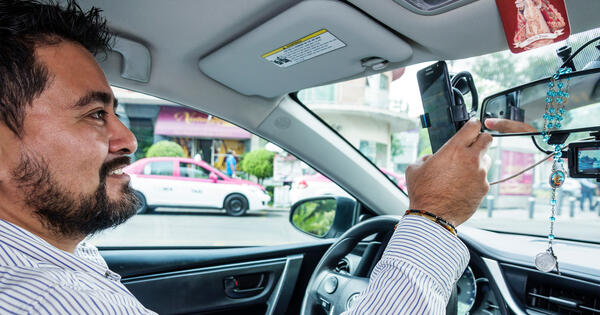When Cash Isn’t an Option, Consumers Lose Out
To many economists and policymakers, cash is a problem: cash transactions are harder to tax, it can be used by criminals, and those who keep their savings in it miss out on interest. Such concerns have driven recent arguments for demonetization, including a 2016 effort in India to remove some large-denomination banknotes from circulation. But for the consumers who use it, cash offers significant benefits: it is widely accepted, offers privacy and anonymity, and allows people without bank accounts or credit cards to participate in the economy.
In a new paper, Yale SOM’s David Argente and the University of Chicago’s Fernando Alvarez use real-world experiments in Mexico to derive a model that quantifies the value of these benefits, in the case of a specific type of good: Uber rides. They find that the value of being able to use cash to pay for Uber rides is worth roughly about half of what a rider spends each year on the app—in other words, riders would pay a 50% premium to keep the cash payment option open.
That means that a ban on using cash would materially reduce the benefits that people enjoy when they use it, a concept known as “consumer surplus.” Whether it’s because “you care about your anonymity, or because transactions are faster, or because it allows you to keep better control of your finances,” Argente says, the consumer surplus number captures all of these benefits of using cash for Uber rides in a single metric. “This is a classic monetary economics question.”
“If you want to do the accounting of, ‘Should we get rid of cash?’, you need to consider cost and benefits,” he continues. “The benefits might be reductions in crime, they might be reductions in informality, but the cost of getting rid of cash is all of this consumer surplus.”
Argente, who grew up in Mexico City, had learned from his brother, an employee of Uber Mexico, that the company faced different regulatory regimes in different Mexican cities, with some banning cash payments while others permitted them. He also knew that while in the broader economy, widespread cash usage is generally replaced with credit card payments as the economy formalizes, Uber’s payment system went the other direction. Initially, riders could only pay with a card that was registered in the app, but Uber later rolled out the cash option in a number of low- and middle-income countries, including Mexico, which expanded its customer base significantly.
In Mexico, Argente notes, cash is used for an estimated 90% of transactions under $25, and many Mexicans receive their wages in cash. However, some cities and states banned cash payments for Uber rides, prompting a lawsuit by the company that went all the way up to Mexico’s Supreme Court. In 2018, the court ruled the ban from the state of Colima unconstitutional on the grounds of financial inclusion, arguing that the most financially marginalized people were the most likely to be harmed.
That’s exactly what economic theory would suggest, but Argente and his co-author wanted to know more: sure, banning cash payments harms low-income customers—but by how much? They sent a proposal to Uber’s research team at their San Francisco headquarters, outlining several field experiments that would test how willing cash-only customers, or customers who used a mix of cash and card, were to substitute their method of payment. (Argente stresses that they had total independence in their research and no financial relationship with Uber; in fact, he notes, the company “didn’t even pay for our Ubers when we went to see them!”)
By using experiments involving discounts, as well as incentives to use different kinds of payments, they could see both how elastic the demand was for rides, and how likely people were to switch payment modes. They complemented their experimental findings with existing data from Panama, where the government introduced strict licensing requirements for Uber drivers in 2018, causing the number of drivers to fall and prices to effectively double. The requirements also led to a sharp fall in the number of rides and a 30% drop in the share of riders paying in cash, suggesting that lower-income riders who are more price-sensitive are also those most reliant on cash. The researchers also used data from the Mexican state of Puebla, where a cash ban in December 2017 led about 30% of cash-only users to register a card.
In one experiment, riders were either offered 10% or 20% off depending on what type of payment they used or the same discounts irrespective of payment method, which showed Argente and Alvarez both how willing riders were to substitute one payment type for another, and how a discounted price affected their demand for rides in a given week. They found that the discounts for cash had only minimal effects on ridership and payment behavior. “The reason is that it’s very hard for mixed users to substitute from cash to card,” Argente explains—perhaps they don’t have money in the bank and don’t want to use a debit card that will incur an overdraft, or they get paid in cash and simply want to spend the cash that’s in their pocket.
In another experiment, they offered pure cash users discounts of 10%, 15%, 20%, or 25% to see how much more they traveled when prices were lower, and found that the discounts had only a small effect. In a third experiment, they offered incentives worth the value of one, two, or three average rides to cash-only riders if they registered a card (they did not have to use it, just register it). The largest incentive, worth about $15.20, increased the likelihood of registering a card by 3.9%, compared with a 1.6% likelihood for the smallest reward of $5.20. Finally, they surveyed more than 6,000 Uber customers about how discounts or large price increases would affect their riding behavior, receiving answers that largely aligned with their estimates from the experiments.
Combining all of this data allowed them to estimate an overall loss in benefits resulting from a cash ban that amounts to 50% of an average rider’s annual Uber expenditures. Consumers, Argente explains, “are willing to pay 50% of what they pay in Uber rides in a given year just to keep the Uber cash option open”—a significant consumer surplus. On average, those who pay purely in cash spend about $80 a year on Uber rides, so this is a loss in benefits worth about $40, while those who use both cash and cards spend around $200, meaning the value of their loss is $100.
To Argente, these findings, as well as observations of experiments such as India’s attempt at demonetization, suggest cash bans “in developing countries will be very costly,” with the poorest households paying the largest costs. In policy terms, that means “we should not do it in developing countries that are very cash intensive,” but instead focus such efforts on higher-income countries. Sweden, he points out, has successfully transitioned to an almost cashless economy.
Argente also notes that the purported benefits of eliminating cash may also not be especially large. He and colleagues had earlier found little reduction in crime as a result of moving away from cash. For countries that do want to attempt it, he suggests studying countries such as Brazil and Kenya, where popular digital payment systems are in wide use. But this new research shows that simply banning cash without an appealing alternative can do more harm than good. “Overall, the evidence that we have is that getting rid of cash will bring more costs than benefits at this point,” Argente concludes.













